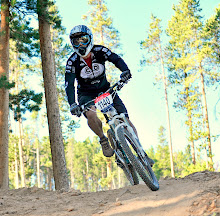After a medial meniscus tear surgery in 2007 and daily reminders of aging knees, I was curious about what the Topeak cadence ready computer could tell be about how I was treating the knees when ascending 8-15% grades on training rides and what methods I need to employ to stay ahead of the use vs. pain/damage game.
The 2010 Yeti 575 weighs in at 27.4 pounds with the Conroy approved Race package. While focusing on a respectable Firecracker 50 finish, rides center around continuous climbing and coaxing the quads and hamstrings to getting accustomed to pushing for up to 7 hours at a time.
 Sunday's ride starting with a crankset punishing tour of Hall Ranch in Lyons via the "rock garden" and a lazy lap around the Hall homestead lollipop that was a 9 mile warm up. Only 1 rock fight along the nasty trail. Rock won. Knee, elbow and left ass cheek bear evidence of the battle. That will heal and I'm ready for some endurance training.
Sunday's ride starting with a crankset punishing tour of Hall Ranch in Lyons via the "rock garden" and a lazy lap around the Hall homestead lollipop that was a 9 mile warm up. Only 1 rock fight along the nasty trail. Rock won. Knee, elbow and left ass cheek bear evidence of the battle. That will heal and I'm ready for some endurance training.Returning back to the Hwy. 7 trail head allowed me to drop the empty Powerbar Sun Tea Endurance bottle and do a quick blood glucose level check. 130....good to go. Out on the road to the short 2 mile trip along the Old St. Vrain Road to the Heil Ranch connector trail head and we're climbing single track for the next 45 minutes. Fruita riding comes to mind as you wind through the conifer laden rocky landscapes with limited visibility on the tight turns and switchbacks. Old farmstead and abandoned 1960's jalopy make the ride interesting.
After topping out on the Heil loop, we descend to the Lefthand Canyon trailhead and visit the bio-friendly outhouse, eat a Powerbar and head back up the 2.5-mile Wapiti Trail, the 2.6-mile Ponderosa Loop Trail, the 3.0-mile Wild Turkey Trail, and then on to the 5.2-mile Picture Rock Trail return. Bottom line is that we were doing 4 1/2 hours pedal time and 34 miles of no rest 5,600 ft. elevation climbing.
Mountain bike cadence and endurance.Studies have been done on the subject and Bio-mechanical expert Todd Carver offered the following words of wisdom. "We did a cadence study on Sugarloaf Mtn Road in 1999 and had 15 roadies climb it with 2 different gearing options. 1st trial was with traditional road gearing. 2nd trial we swapped their rear cassette and rear der for a MTB setup. Results: on average, they were the same speed. But there was some variability and some of the larger riders were faster when using the MTB gearing. The climbers seemed to be unaffected. Conclusion was that individual riders need to know their "RPM zones" that work best for them and use them.
The Topeak Panorama V16 cadence indicator coached me to maintain my personal best climbing pace in middle chainring and granny at 90-95 RPMs. I can do this all day.When asked about effects on knee stress at low RPMs while climbing, Carver said "Conventional wisdom says to spin. But sometimes I see some injuries just from really high cadences just due to the repetition.". As a Quality Assurance professional, I know that you can not manage what you can not measure. The Topeak cadence set-up on the MTB allows you to measure and manage your output for best performance. Cadence is courtesy of the swingarm mounted sensor and its relationship to the crankarm mounted magnet.
The V16 offers data on current speed, average speed, max speed, pace, current RPMs, average RPMs, max RPMs, ambient temperature, ride time, and accumulated ride time. A clock, stopwatch, total distance reading review and the accumulated distance data completes the package. Your choice of metric or English units and a low battery indicator.
The massive 2 foot square instruction sheet gives details in several languages and provides a wheel circumfrence chart for setting the computer to your bike. Always use the method "B" of rolling your wheel 360 degrees and multiplying by Pi to determine this dimension. Wheel speed info is funneled from the wheel mounted magnet through the wireless transmitter.







































2 comments:
Interesting case study... I look for it to be published soon in JAMA.
Post a Comment